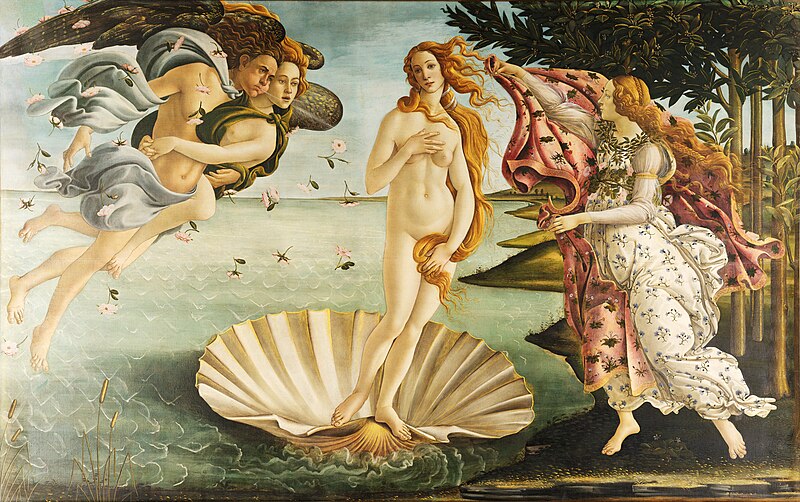Sandro Botticelli
(Italian Early Renaissance, c.1445–1510)
Botticelli belonged to the Florentine School under the patronage of Lorenzo de' Medici.
Left to right: Zephyrus, Chloris, Venus, Horae.
 |
| The Birth of Venus - Botticelli - tempera on canvas (173 × 279 cm) c.1486 - Galleria degli Uffizi |
It depicts Venus, having emerged from the sea as an adult woman, and being blown to the Cyprus sea-shore to be clothed. Roses are flying in the air on the left, and spring flowers are imprinted on the clothes to the right.
Botticelli's Venus was so pleasing that her unusually long neck and unusually slanted shoulder are usually not noticed.
The painting again was commissioned by the Medici family of Florence.
Venus de' Medici
The church did not approve nakedness nor non-Christian gods/goddesses, that Renaissance artists brought back from Ancient Greece or Roman eras.
After the Medici family lost influence and got expelled from Florence, Botticelli got no more works, and eventually lived and died in loneliness and poverty.
After the Medici family lost influence and got expelled from Florence, Botticelli got no more works, and eventually lived and died in loneliness and poverty.
 |
| Venus de' Medici Galleria degli Uffizi |
- The pose of Botticelli's Venus is reminiscent of the Venus de' Medici, a marble replica sculpture from classical antiquity in the Medici collection which Botticelli had opportunity to study.
L-R: Mercury, the Three Graces, Venus, Flora, Chloris, Zephyrus.
 |
Primavera / Allegory of Spring - Sandro Botticelli - tempera on panel (202 × 314 cm) c.1482 - Galleria degli Uffizi (Florence) |
 |
| Judith's Return to Bethulia with the Head of Holofernes - Sandro Botticelli - tempera on wood (29 x 21 cm) 1470 - Uffizi Gallery (Florence) |
.jpg) |
| Pallas and the Centaur - Sandro Botticelli - tempera on canvas (204 × 148 cm) c.1482 - Uffizi (Florence) |
 |
| Venus and Nars - Sandro Botticelli - tempera on panel (69 × 173 cm) c.1485 - National Gallery (London) |
 |
| The Calumny of Apelles - Sandro Botticelli - tempera on panel (62 × 91 cm) 1494-95 - Uffizi (Florence) |
(R) He was buried with his family outside the Ognissanti Church in a spot the church has now built over.


No comments:
Post a Comment